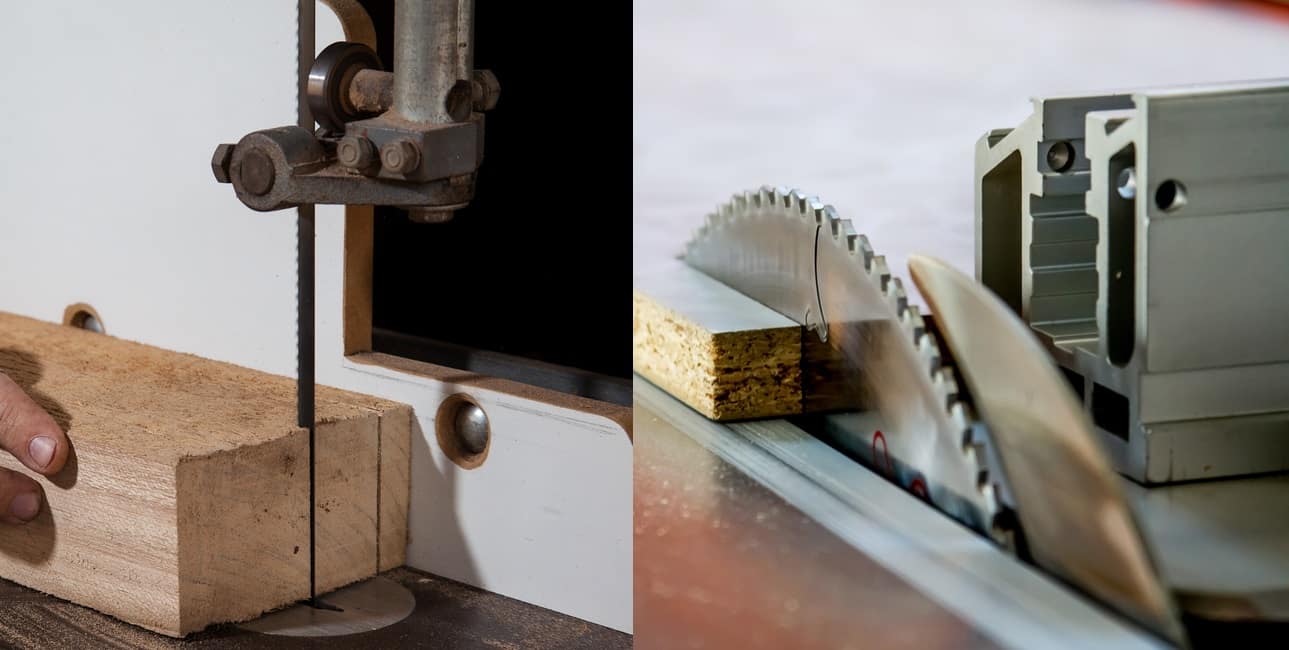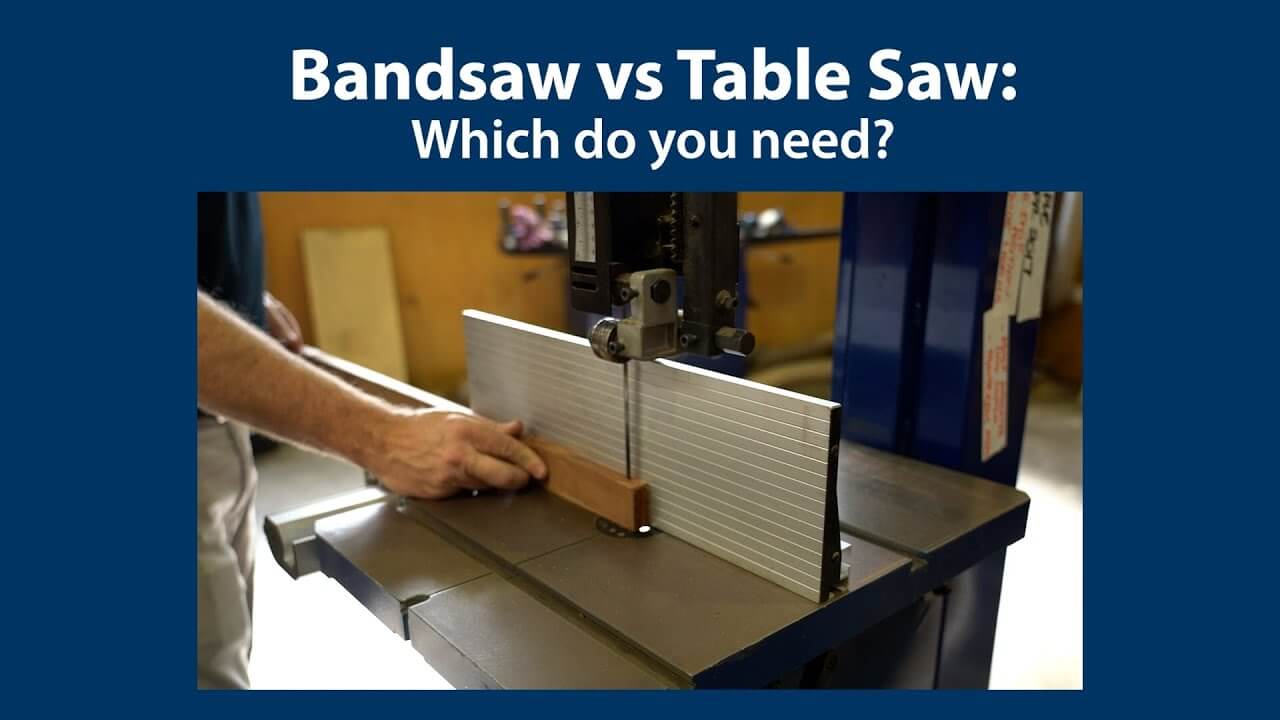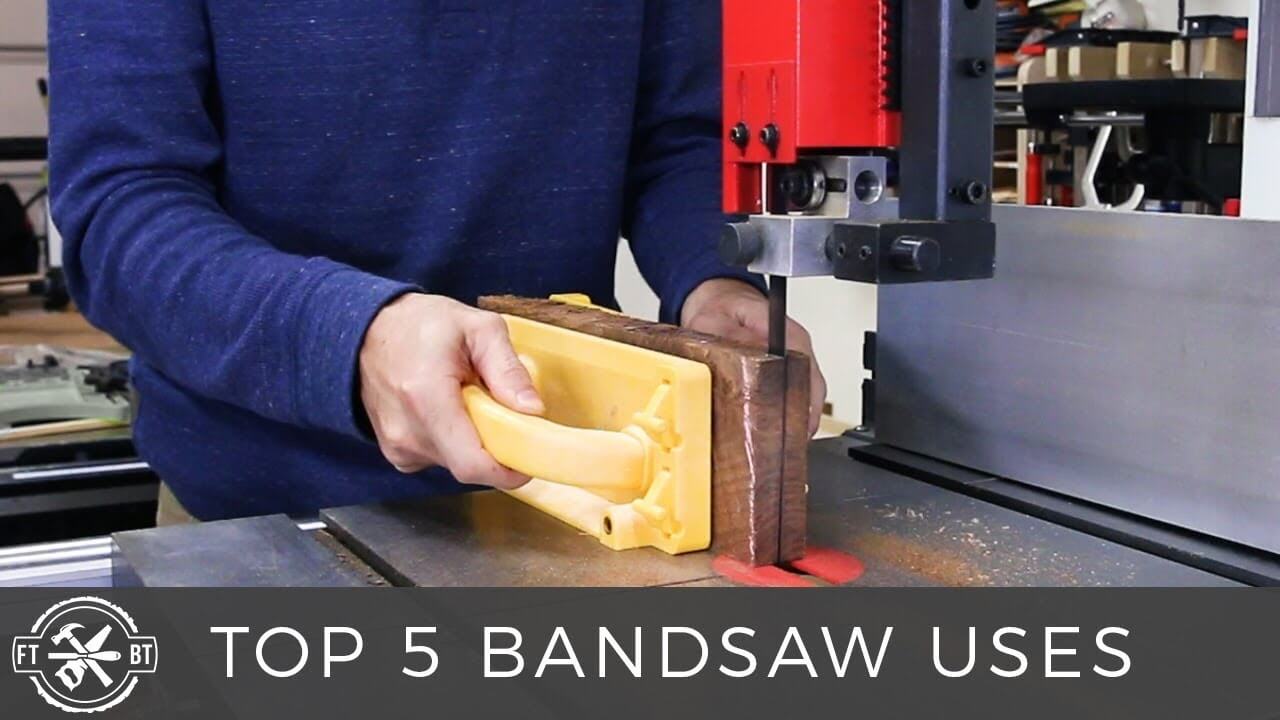Table Saw vs Band Saw: Which Is Better?
Table saws are the bread and butter of a woodworker’s toolbox. They are highly multi-functional pieces of equipment and have many different uses. Most beginners will start with a table saw.
The band saw is primarily used for cutting corners into various materials. They are a great addition to any workshop but will not produce cuts that are as straight as a table saw or a track saw.
If you are confused about which to get, look no further. We have gone through all of the different characteristics a woodworker should contemplate when considering purchasing a new table saw vs a band saw.
It is hard to make a blanket statement on which saw is better as it completely depends on your circumstances.
Which Is Better Table Saw or Band Saw?
The table saw is often seen as the workhorse of any workshop and is excellent for ripping boards or sheets. This is because when compared to the like of a band saw, a table saw’s rip capacity is far greater.
A table saw usually takes a prime position in the center of your workshop, and then everything else you purchase just kind of falls around it.
However, you might still struggle with the whole table saw vs band saw the decision as both saws are primarily used for different purposes.
Note, when determining which is better for you, it is important to ask yourself a few questions:
The answer to this question really depends on what you plan on doing. If you want to build and assemble furniture made of plywood, then a table saw may be the best go-to option. You can make accurate clean cuts, work with plywood, melamine, or veneered boards, and produce repeated crosscuts when necessary.
It’s even possible to make angled bevel cuts or even taper cuts with a table saw. Think of a table saw as the free safety of the football world. They can really do it all, yet won’t cost you a fortune.
However, if you hope to work more with solid timber, then a band saw may be an option to consider instead. Keep in mind that you may not be able to achieve as good a finish as you would with a table saw, but you can save on floor space and have something more versatile in your wood shop.
What Are the Advantages of a Table Saw?
Table saws are fantastic for cutting straight lines. They cut cleanly and precisely, making them ideal for squaring off the ends of materials.
Table saws are also good for making compound, mitered, and bevel cuts. While miter saws can also perform these same cuts, when comparing a miter saw vs a table saw to rip boards of wood, a table saw is the better alternative.
Another added benefit of table saws is that they are pretty much maintenance-free, at least compared to band saws. The blades on table saws are very much easy to swap out.
They can often be re-tensioned, and you can always spend a few hours conducting some DIY maintenance by cleaning and sharpening the blade on your table saw. Honestly, this is something that most people tend to neglect but will pay dividends in the long run if you stick to a schedule.
Table saws also have an adjustable depth, making them ideal for a whole host of intricate woodworking projects.
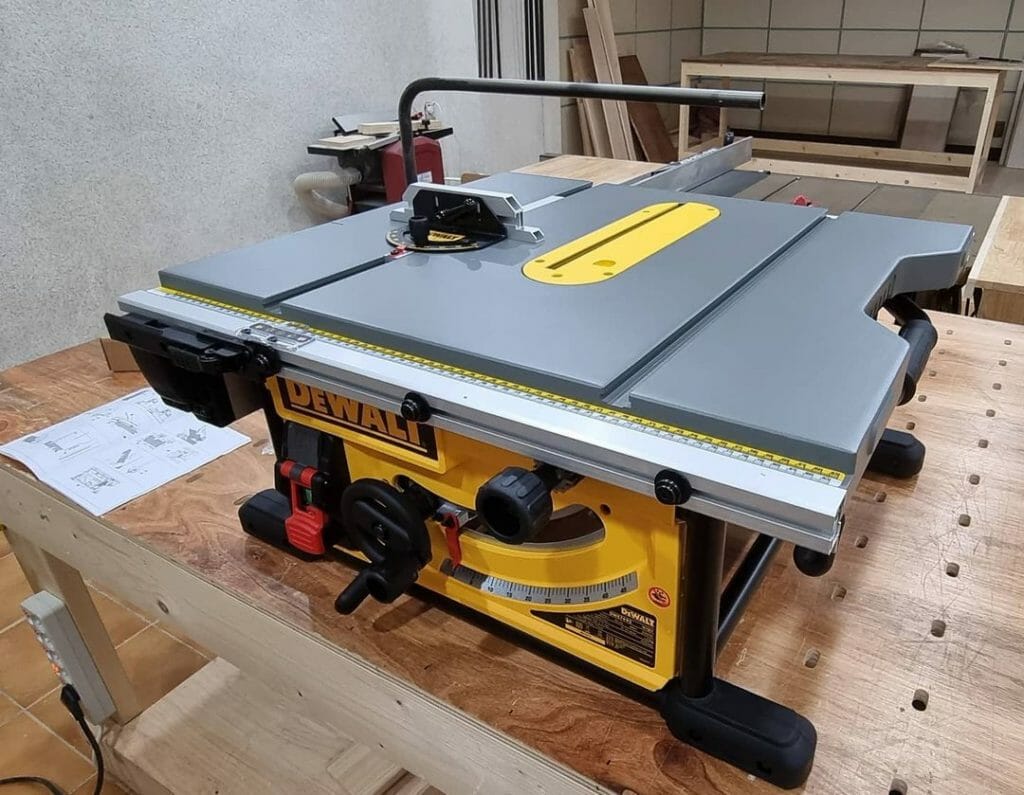
What Are the Disadvantages of a Table Saw?
Firstly, the flat, straight edges of a table saw mean that they are not ideal for cutting curved edges, unlike band saws.
The radius of the blade limits the depth of the material you can cut. The positioning of the blade makes it easier to injure yourself if proper care is not taken.
You need a larger workshop to fully appreciate a table saw. Not only do they take up a lot of space on the floor, but you also need a lot of clearance around the working area to manipulate your materials.
Table saws are relatively louder than band saws. So, if you plan on operating your new table saw outside near some annoying neighbors who like to bust your balls, you might want to reassess its ideal location.
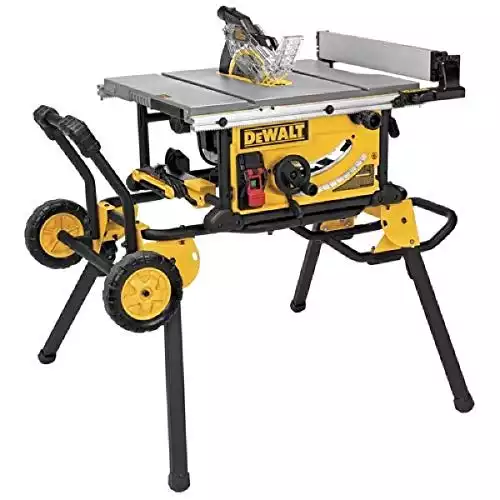 DEWALT DWE7491RS 10-Inch Table Saw
DEWALT DWE7491RS 10-Inch Table Saw
- This DeWalt table saw has a 10-inch 240tooth carbide blade, a rolling stand, push stick, miter gauge, rip fence, 2x blade wrenches, and blade guard assembly manual.
- Heavy-duty powerful Jobsite table saw that is robust enough to be the centerpiece of your home workshop at an affordable price point.
- It has a 32 ½-inch rip capacity to the right of the blade and a 22-inch rip capacity to the left of the blade.
- Easy blade height and angle adjustments are made smoothly via rotating the flywheel with a depth of cut at 45° – 2-1/4” & depth of cut at 90° – 3-1/8”.
What Are the Advantages of a Band Saw?
Band saws excel when cutting along curves, but they can also cut straight lines relatively easily. They are likely to need a little extra sanding, though.
Band saws are a great tool to roughly size the material you are working with initially. They have a deep blade, meaning that thicker materials can be cut too.
They tend to be safer to use than table saws and have a lot of different blade types. These are often less expensive than a table saw blades.
It does not require much floor space to install and can sit against a wall. This saves you a lot of square footage in the workshop. They are also quieter than table saws when in operation.
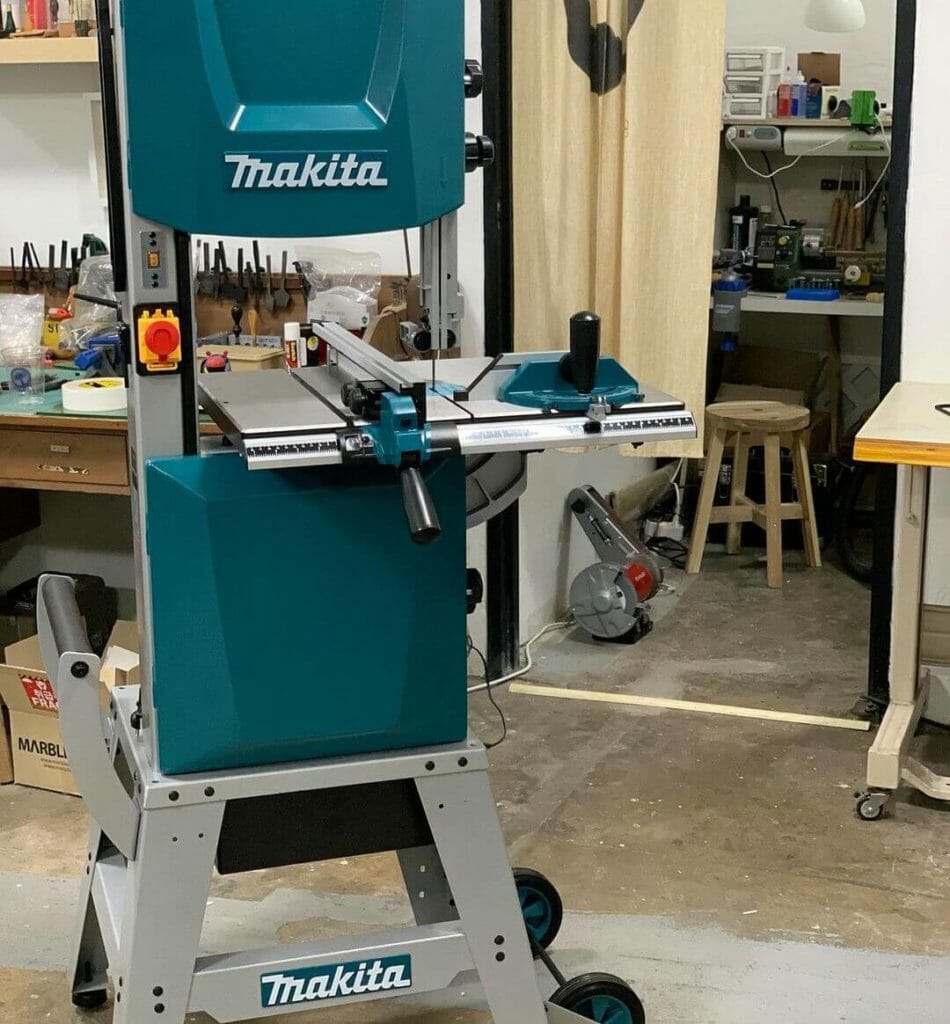
What Are the Disadvantages of a Band Saw?
The finish on the cuts is often less smooth when compared with the cut of a table saw. The blade on a band saw is prone to some slight movement during the cutting process meaning that the cuts are less accurate.
There’s also some extra maintenance required with band saws vs table saws, and it also takes a little longer to change out blades when switching materials. It’s not a deal-breaker, but something to consider nonetheless.
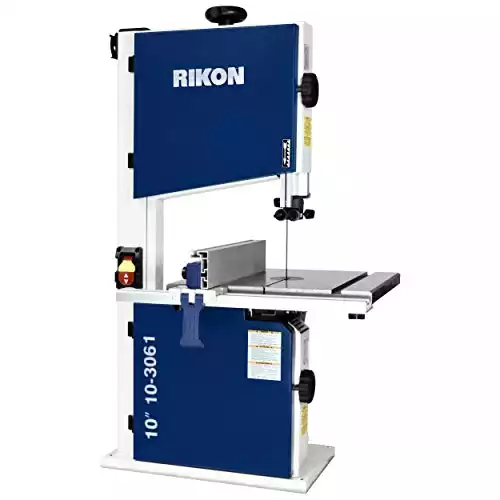 Rikon 10-3061 10" Deluxe Band Saw
Rikon 10-3061 10" Deluxe Band Saw
- The best quality 10-inch budget band saw on the market that is ideal for beginner woodworkers and or DIY hobbyists.
- A great option for those with limited space as it can be used with or with a stand, and can be utilized on a bench-top.
- Equipped with a dust collection so you can maintain a clear line of sight on the guide column to your workpiece.
- Runs super quiet compared to other band saws and has an excellent finish to it with an accurate and flat table.
How Do Table Saws vs Band Saws Differ in Functionality?
Materials such as veneered boards, melamine, or plywood are best cut on a table saw. This is because you require sharp edges to join the pieces together.
Solid timber is better suited to a band saw. This will not give you such sharp edges, but as you are likely to plane the edges afterward, it doesn’t matter.
Cutting Capacity: Table Saw vs Band saw
Table saws are perfect for cutting straight lines. If you add on a sliding table, they can be extremely precise too.
This makes them ideal for parallel and corner cuts. The resultant cuts are often very smooth and do not need much sanding.
As the blade on a band saw is thin, it tends to move a little while cutting. This is because the blade is relatively thin in comparison to the material.
The strain of cutting through the wood while sawing can cause the blade to wobble, resulting in an uneven cut. It is good for cutting along curved edges.
One area where band saws have a clear advantage when it comes to cutting capacity is in resawing. Band saws make it easy to create veneers and help to reduce workshop waste. This is not really possible with a table saw.
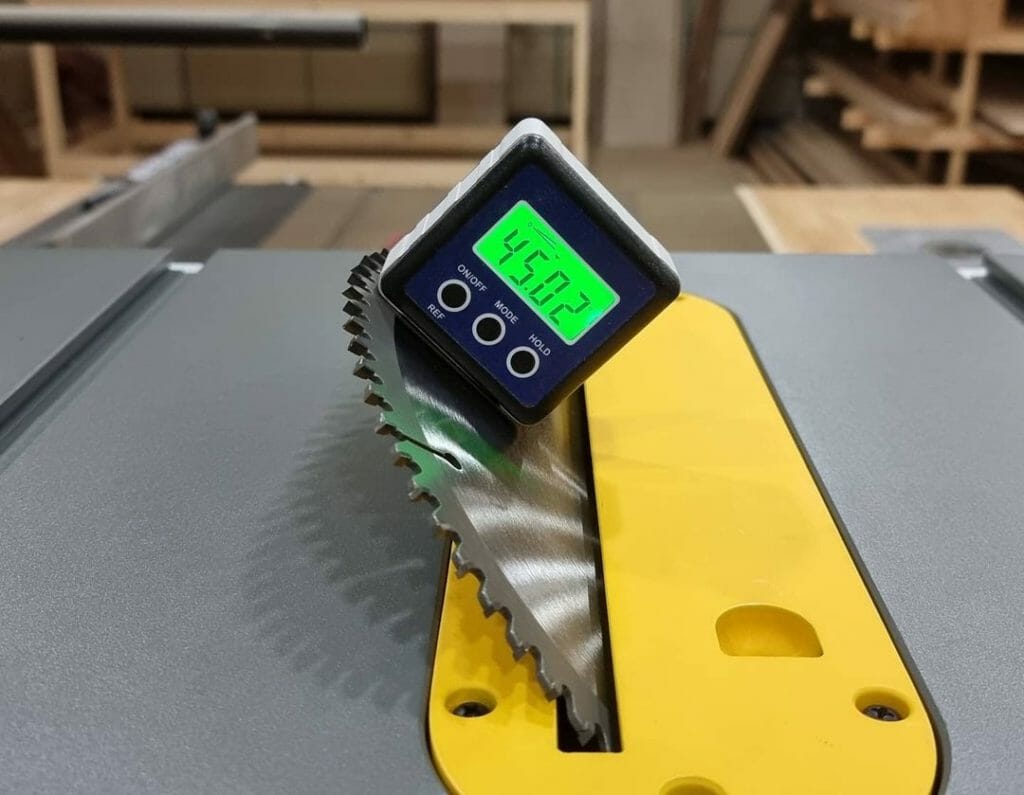
Size Advantages & Disadvantages
As the name suggests, table saws are installed, complete with a table to work and cut on.
These tables are often fairly large and take up a lot of space in your garage or workroom. This means that you will sacrifice a lot of space for your saw, potentially impeding other products.
In contrast, band saws tend to have a smaller area requirement but are much taller. They can be located next to a wall for support, taking up relatively little space.
Both saws require a clearance area around the machine. This is to allow space for the infeed and outfeed. In other words, you need enough space around the saw to manipulate the material you are working with.
Changing the Blade: Table Saw vs Band Saw
Working with different materials requires you to change the cutting blade often. It is useful to be able to easily and quickly switch the blades out.
It is very simple to change the blade on a table saw. Often it will be held in place on the arbor with a nut.
Undo this with a wrench and take the blade off. Place the new one on, tighten the nut, and you’re good to go.
A bandsaw requires a lot of adjustments before the new blade can be used. You will need to monitor and adjust belt tensions, and if they start to wear, the bearings might have to be replaced, which can take up a lot of time.
To circumvent this issue, larger commercial workshops may have more than one bandsaw.
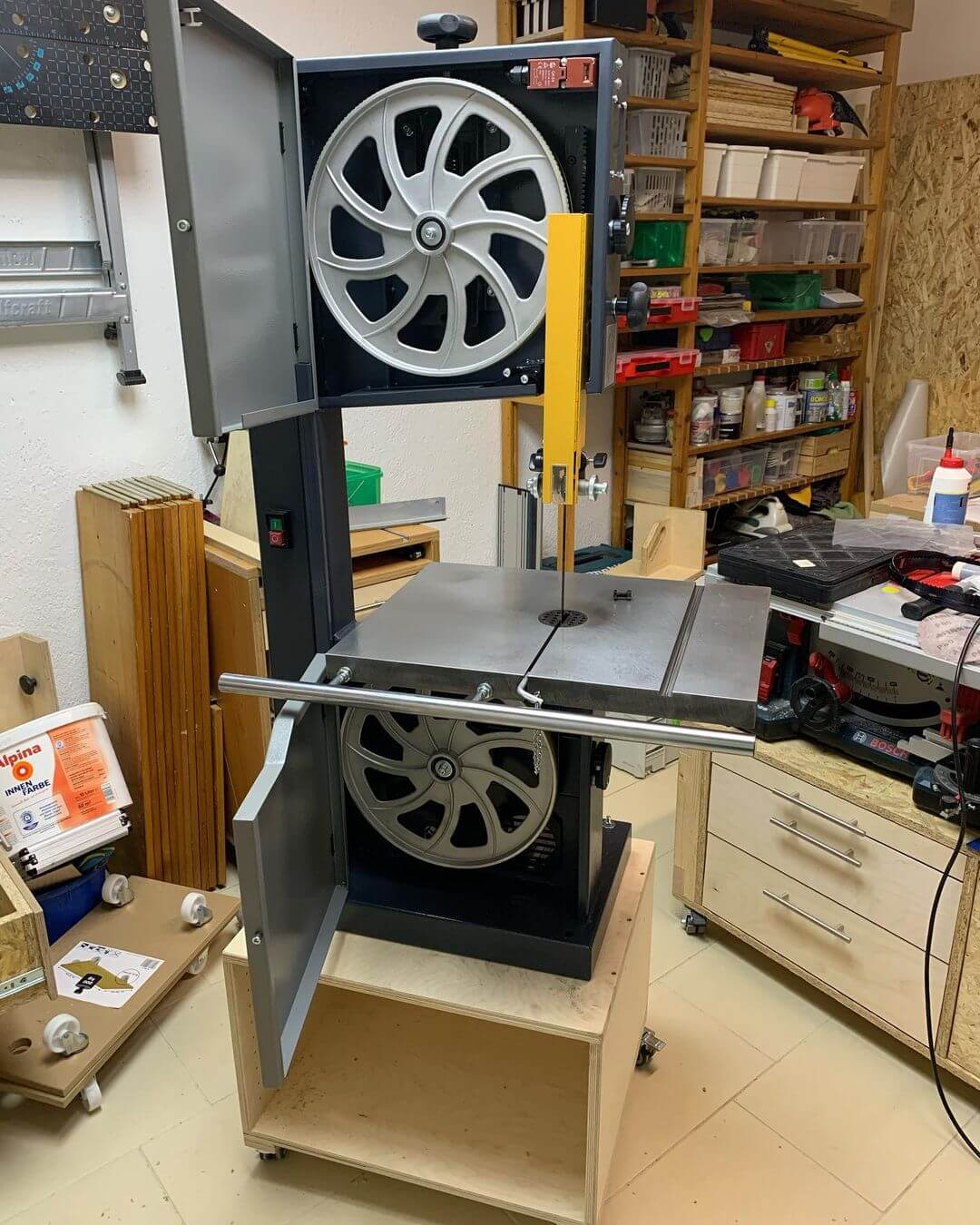
What Material Can Either Saw Cut?
As we mentioned above, you will need different blades according to what is being cut. Thick materials often cut better with a band saw.
This is because the maximum blade height on table saws is usually around 3 ½ inches, meaning that anything thicker than this will not be cut properly.
What About Kerf?
Actually, what in the hell is Kerf? Kerf simply refers to the amount of material cut off by the blade.
Band saws have a smaller kerf as they have a smaller blade, meaning less can be cut off. A full kerf is 1/8 inches, and a thin kerf is 3/32 inches. Less power and muscle are required of your woodworking machine when forcing a thin kerf blade through solid wood, compared to a full kerf.
As a woodworker, you must pay attention to the kerf width to maintain precision when cutting parts for furniture or other fine woodworking pieces. A thin kerf blade should be used if you have a woodworking project that requires thin-strip ripping.
A thin kerf will prove to be less wasteful. A full kerf blade thickness is more for strength and durability for thick material and pieces of wood. A full kerf blade works best on a saw with three or more horsepower since it can handle the larger size much more easily.
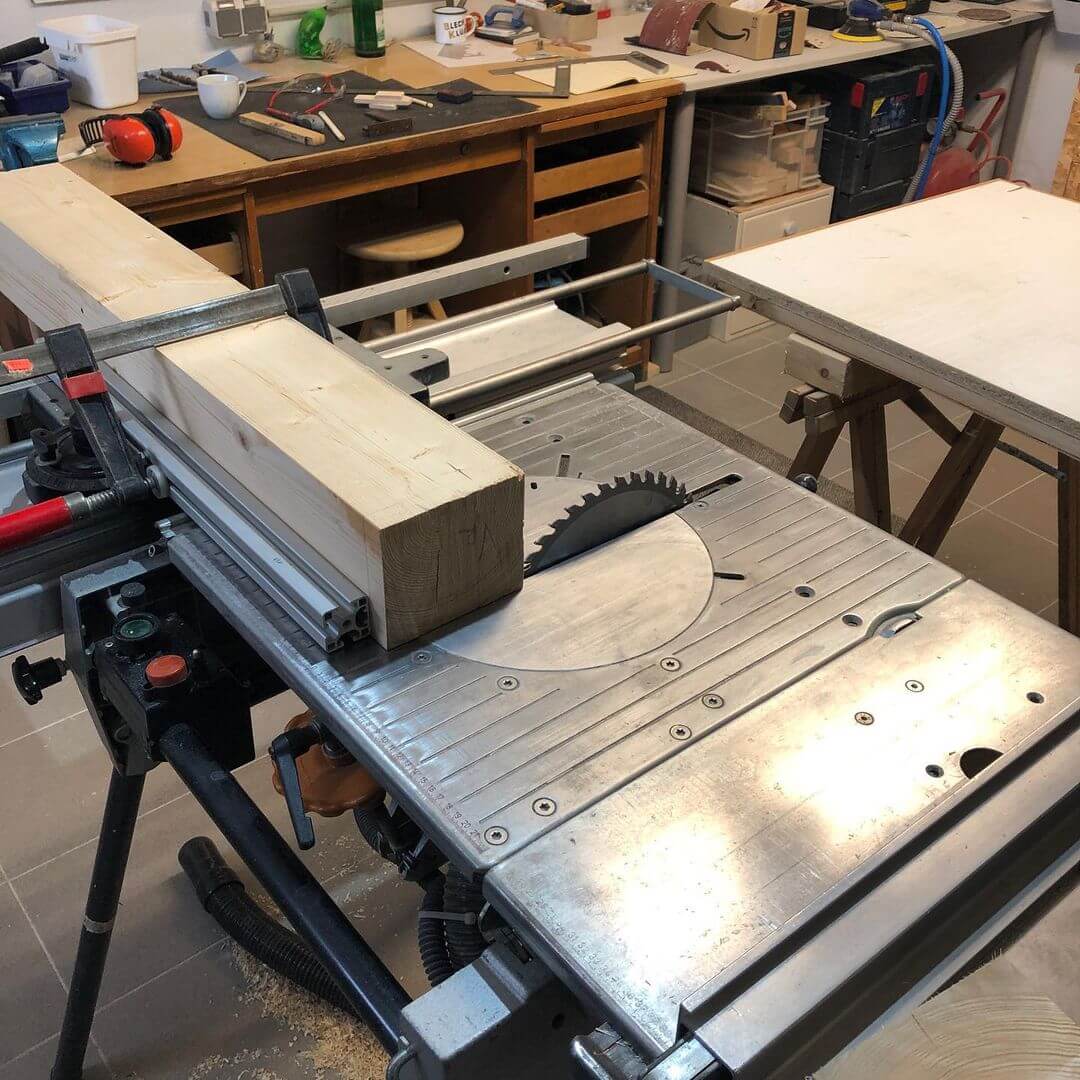
Safety Concerns With Table Saws and Band Saws?
Both saws come with their fair share of safety issues, but this is true of any heavy machinery. It is vital to wear appropriate protection such as safety goggles, and an apron, and have long hair tied back.
Using a band saw or table saw safely should always be your number one priority, and you should never operate heavy machinery under the influence of alcohol or drugs. If you do not know what you are doing, we strongly recommend contacting a qualified professional.
That being said, band saws tend to be safer to operate than table saws.
They cut in a downward direction towards the worktable, whereas table saws cut towards the user. This means that there is less chance of kickback from the material being cut.
It is important to use a riving knife on a table saw to reduce the risk to the operator.
Can a Band Saw Replace a Table Saw?
There is some slight overlapping when it comes to the basic functions of a band saw, and table saw; however, neither tool can really replace the other. You need to take a closer look at the benefits and features of each to make the best choice for the project you are working on.
Band saws have been used in both woodworking and metalworking and have a long, looped blade tensioned between rotating wheels. While a table saw can cut metal, if you looking to make precise cuts into non-ferrous or ferrous metal, a band saw would be the better option. A band saw blade is thinner than a table saw blade and gives it a much thinner kerf for more precise cuts.
While both tools can make similar cuts, you can’t have one replace the other’s full function. Instead, consider purchasing a high-quality band saw AND a high-quality table saw for your wood shop, so you have the best of both worlds.
However, if you can only find it in your budget to choose one: table saw vs band saw, then you will find more in the way of versatility, precision, and power when you choose a quality table saw.
A table saw has more in the way of ability than a band saw. You can make everything from a rip cut to a taper cut, or even an angle cut with a table saw, by merely making some simple adjustments.
Plus, if you need to make a more intricate curved cut on occasion, you can always pair your table saw with an affordable scroll or jigsaw.
Can You Make a Bevel Cut with a Band Saw?
A band saw can cut a variety of things, including cutting curves and irregular cuts. However, with a band saw, you can also make crosscuts, rips, a bevel, miter cut, compound curve, and other special and more intricate cuts.
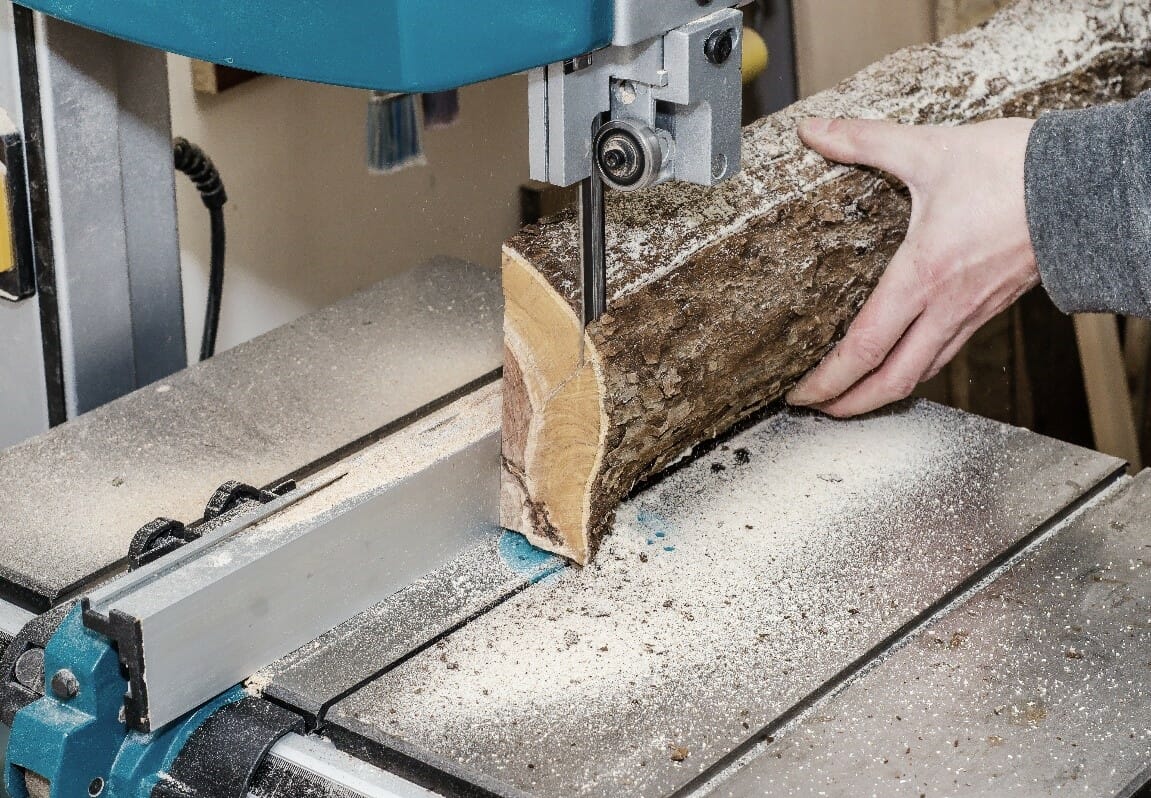
Head to Head Comparison: Table Saw vs Band Saw
You will find that both saws are similar in some of their features, but they have different capabilities.
The Blade
The blade of a table saw, and a band saw are both powered by either a direct-drive or belt-driven motor. The difference between which type of motor is used comes down to both the blade size and the general build of either saw.
A band saw has a thin and narrow blade that is flexible, while a table saw like a circular saw, uses a thicker and more circular carbide blade to make a clean and precise cut.
A table saw blade is usually mounted on an arbor and connected to the motor. Table saw blades have razor-sharp jagged teeth which are exactly why they are used to cut through various dense materials.
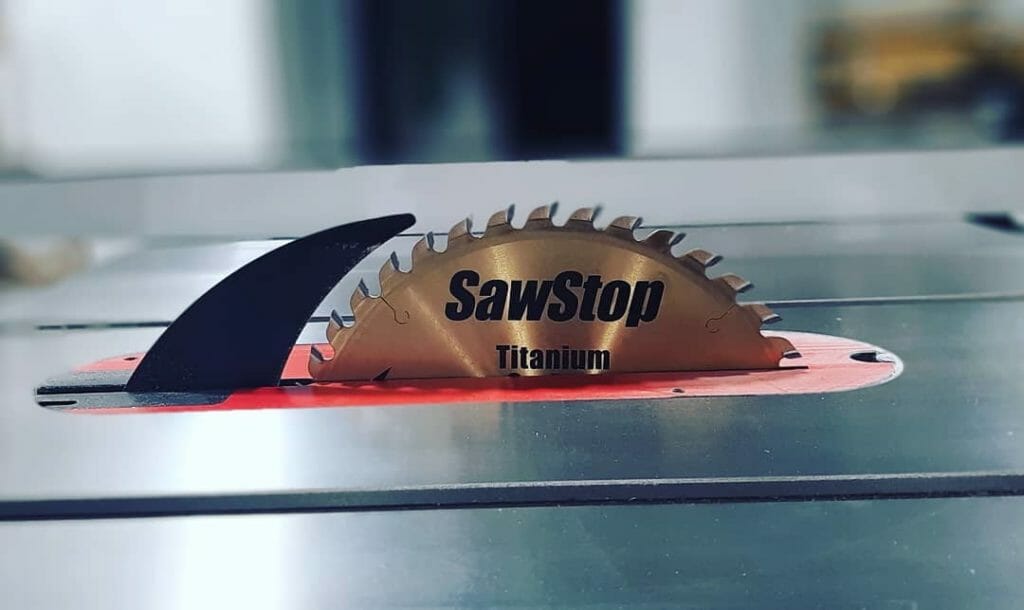
Speed
Speed is another great factor to consider when purchasing a saw. Both the table saw and band saw are almost neck and neck when it comes to speed. They both utilize powerful motors. A band saw can go up to 1,000 feet per minute, and the table saw blade rotates at around 3500 RPM.
Noise and Dust Collection
If you want something with a quieter operation, then a band saw is ideal. The blades cut downward and are narrow, which also results in less dust as you work.
Table saws, however, produce a lot of dust because the blades are typically thicker, and you have a wider kerf. This results in a dusty workshop if you don’t have the proper dust collection solution in place.
Price
Cost is always a concern as well when you purchase power tools for your wood shop. Table saws and band saws cost more than other power tools.
A table saw will prove to be more expensive. You can find a quality band saw for under $200, while a table saw will cost as much as around $300 or more. The more sophisticated the saw you choose, the higher the price tag will ultimately be.
In Conclusion
If you’re fortunate enough to have the money on hand and the necessary space available, we suggest purchasing both a table saw, and a band saw.
Although you’re somewhat limited in one of these respects, we would suggest further evaluating what your main use of the saw will be and choosing based on immediate needs.
Unless you are focusing on creating curved cuts primarily, we suggest getting the best table saw you can afford. They are more versatile and easier to use.
Either way, you should always take great care when operating any heavy machinery and wear appropriate protection. Anyway, best of luck with either or saw you select. Owning a table saw, or band saw will allow you to seriously up your craftsmanship skills.

